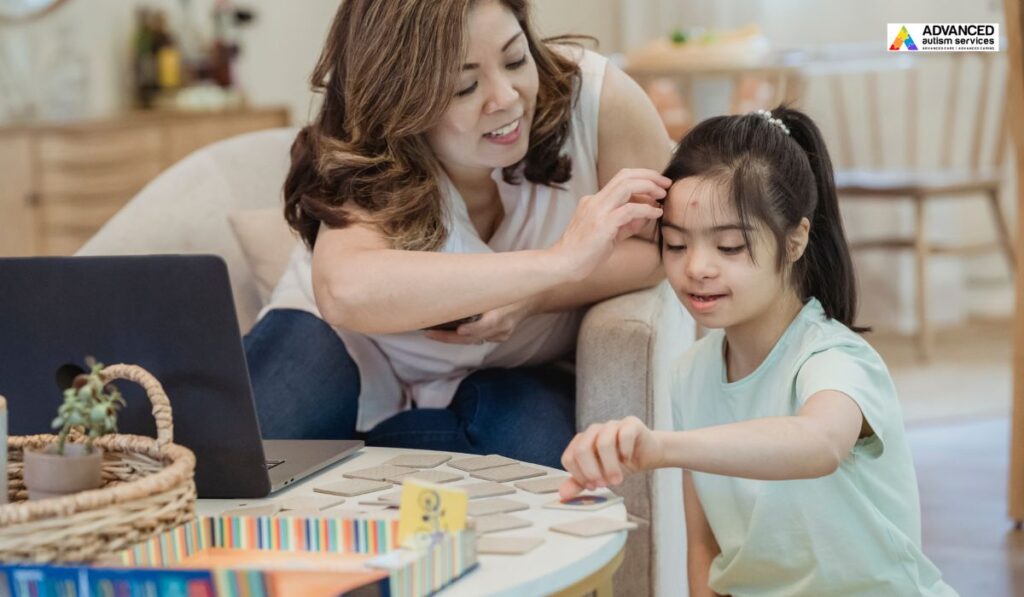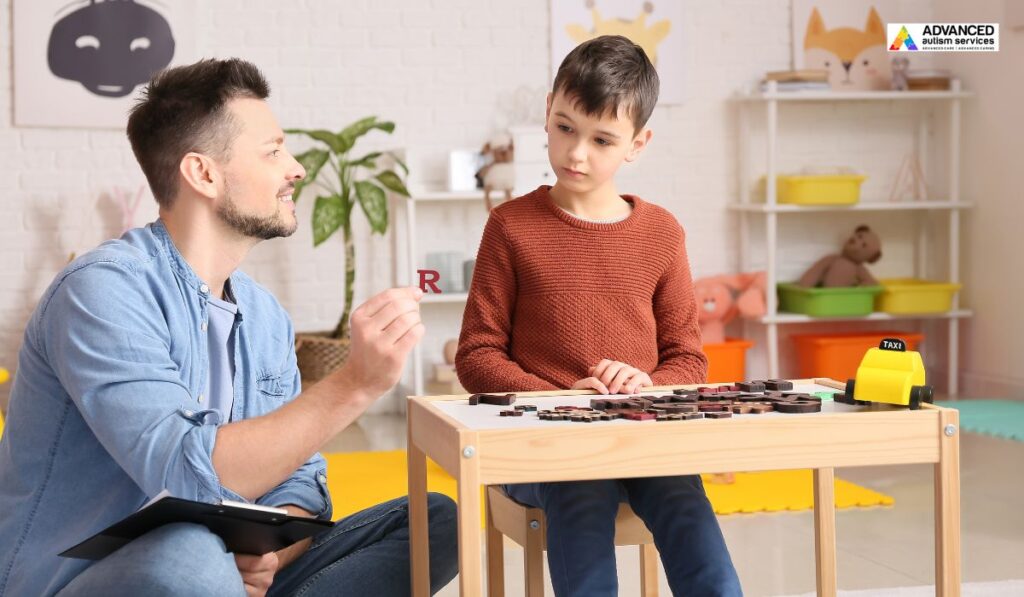- Advanced Autism Care Solutions,
- Advanced Autism Interventions,
- Advanced Autism Treatment Options,
- Advanced Strategies for Autism,
- Cutting-edge Autism Therapies,
- Innovative autism support,
- Leading-edge Autism Support Services,
- Next-Level Autism Intervention,
- Progressive Approaches to Autism,
- State-of-the-Art Autism Therapeutics
Children with Autism Spectrum Disorder (ASD), especially those dealing with advanced autism, often face challenges in making eye contact, a behavior that comes naturally to many. Understanding why eye contact is difficult for children with ASD and recognizing its importance is crucial for parents and caregivers. This article explores the reasons behind the struggle and the significance of eye contact and provides seven practical tips to help enhance eye contact in children with ASD.
Why is eye contact hard in autism?
Eye contact can be challenging for individuals with Autism Spectrum Disorder (ASD) due to a combination of receptive and social factors that are common in individuals with ASD, and direct eye contact may result in receptive overload or discomfort. The intensity of visual stimuli can be overwhelming, making it difficult for them to maintain eye contact without feeling distressed.
In essence, the difficulty in making eye contact for those with ASD is a multifaceted issue, involving challenges in social communication and understanding non-verbal cues. Recognizing and respecting these challenges is crucial in providing appropriate support and accommodation for individuals with ASD.
Why is eye contact important?
Eye contact is essential for several reasons, playing a fundamental role in human communication and social interaction. Here are some key reasons why eye contact holds significance:
Establishing Connection:
Eye contact helps establish a connection between individuals. It is a non-verbal cue that signals engagement and attentiveness. When people make eye contact, it communicates a sense of presence and involvement in the interaction.
Building Trust and Rapport:
Trust is often built through non-verbal cues, and eye contact is a crucial element in this process.
Establishing and maintaining eye contact can convey sincerity and openness, contributing to the development of trust and rapport in relationships.
Conveying Confidence and Assertiveness:
Individuals who make appropriate eye contact are often perceived as more confident and assertive. It communicates a sense of self-assurance and can enhance one’s presence in both personal and professional settings.
Facilitating Effective Communication:
Eye contact is a powerful tool in communication. It helps individuals gauge the reactions and responses of others, allowing for adjustments in their own communication style. It fosters a more dynamic and responsive exchange of ideas and emotions.
Conveying Emotions and Intentions:
The eyes are expressive and convey a range of emotions. Making eye contact allows individuals to better understand each other’s feelings, intentions, and emotional states, contributing to a more nuanced and empathetic communication.
Navigating Social Situations:
In social settings, eye contact is a social norm that signals engagement and interest. It helps individuals navigate various social situations by conveying social cues and signals. Lack of eye contact might be perceived as disinterest or social discomfort.
Enhancing Active Listening:
Eye contact is a crucial aspect of active listening. When individuals maintain eye contact, it indicates that they are focused and attentive to the speaker. This promotes better understanding and encourages a more meaningful exchange of information.
Cultural and Social Norms:
In many cultures, making eye contact is considered a sign of respect, attentiveness, and politeness. Adhering to cultural and social norms related to eye contact is essential for successful social integration and communication.
How can I help my child improve eye contact?
To assist your child in improving eye contact, it’s essential to create a supportive and comfortable environment. Reinforce and praise naturally occurring instances of eye contact, providing positive feedback to encourage repetition. Engage your child in conversations about subjects they find interesting, as this can enhance motivation for making eye contact. Additionally, model appropriate eye contact during conversations, serving as a visual guide for your child to emulate. Break down the skill of making eye contact into smaller, achievable steps, shaping their behavior gradually. Be patient, allowing your child to initiate and control the pace of eye contact while using visual supports, such as social stories or visual schedules, to prepare them for situations requiring this essential social skill.
Looking at Something Else: An Alternative to Eye Contact
Embracing the concept of ‘Looking at Something Else’ offers a compassionate alternative for individuals, particularly those with Autism Spectrum Disorder (ASD), who find direct eye contact challenging. Recognizing the preferences that can accompany conditions like ASD, this approach encourages individuals to redirect their gaze to a shared point of interest or object during interactions. This not only respects their unique needs but also provides a more comfortable avenue for communication. By acknowledging and accommodating the differences in social interaction styles, we can create inclusive environments that foster meaningful connections without placing undue stress on those who may struggle with traditional norms of eye contact.
7 tips to support and encourage improved eye contact in these individuals.
Create a Comfortable Environment:
Ensure that the environment is free from overwhelming stimuli. Reduce distractions and noise to create a calm and comfortable setting, making it easier for children with ASD to focus on the person they are interacting with.
Use Visual Prompts:
Utilize visual cues to guide children’s attention towards the eyes. Point to your own eyes or use pictures of eyes to help them understand the concept of eye contact. Visual prompts can serve as helpful reminders for children who may struggle with nonverbal communication.
Gradual Progression:
Encourage gradual progression by starting with short periods of eye contact and gradually extending the duration as the child becomes more comfortable. Acknowledge and praise even minor improvements to reinforce positive behavior.
Incorporate Fun and Play:
Integrate playful activities into eye contact exercises to make the experience enjoyable. Use games, toys, or interactive activities that naturally draw a child’s attention to your face, fostering a positive association with eye contact.
Be a Role Model:
Children often learn by imitating those around them. Be a positive role model by demonstrating appropriate eye contact during conversations. Encourage family members, friends, and educators to do the same, providing consistent examples for the child to observe.
Use Social Stories:
Social stories are a valuable tool to help children with ASD understand social cues, including the importance of eye contact. Create personalized stories that highlight the benefits of eye contact in different situations, making it easier for them to grasp the concept.
Reward System:
Implement a reward system to reinforce and motivate the child’s efforts in making eye contact. Establish a simple reward chart with achievable goals, and offer positive reinforcement such as praise, stickers, or small treats when the child successfully engages in eye contact.
Conclusion
In conclusion, addressing eye contact challenges in children with Autism Spectrum Disorder (ASD) requires understanding receptive and social factors. This article provides seven practical tips for parents and caregivers to enhance this crucial skill. Recognizing the importance of eye contact in communication, the tips aim to create supportive environments and encourage positive behaviors. For further support and information, visit Advanced Autism Services.
FAQs
Why is eye contact challenging for children with Autism Spectrum Disorder (ASD)?
Eye contact is challenging for children with ASD due to difficulties in social communication. Direct eye contact may lead to receptive overload or discomfort, making it difficult for them to maintain eye contact without feeling distressed.
Why is eye contact important in human communication?
Eye contact plays a fundamental role in human communication and social interaction. It helps establish connections, build trust, convey confidence, facilitate effective communication, express emotions and intentions, navigate social situations, enhance active listening, and adhere to cultural and social norms.
How can I help my child improve eye contact?
To assist your child in improving eye contact, create a supportive environment by recognizing and respecting their choices. Adjust lighting, minimize distractions, and reinforce instances of natural eye contact with positive feedback. Engage them in conversations about their interests, model appropriate eye contact, break down the skill into smaller steps, and use visual supports like social stories or schedules.
What is the concept of ‘Looking at Something Else’ as an alternative to eye contact?
‘Looking at Something Else’ is a compassionate alternative for individuals with ASD who find direct eye contact challenging. This approach encourages redirecting gaze to a shared point of interest or object during interactions and providing a more comfortable avenue for communication.
Can using social stories be effective in helping children with ASD understand the importance of eye contact in different situations?
Yes, social stories can be highly effective. Creating personalized stories that highlight the benefits of eye contact in various situations helps children with ASD grasp the concept more easily. These stories serve as valuable tools for reinforcing the significance of eye contact in a context that is relatable and meaningful to the child.
How can I involve other family members, friends, and educators in supporting my child’s development of eye contact?
Encourage a collaborative approach by involving family members, friends, and educators in modeling appropriate eye contact. Share information about the importance of eye contact in social communication and request their support in providing consistent examples for the child to observe. This collective effort can reinforce positive behavior and create a more supportive environment for the child’s overall development.




